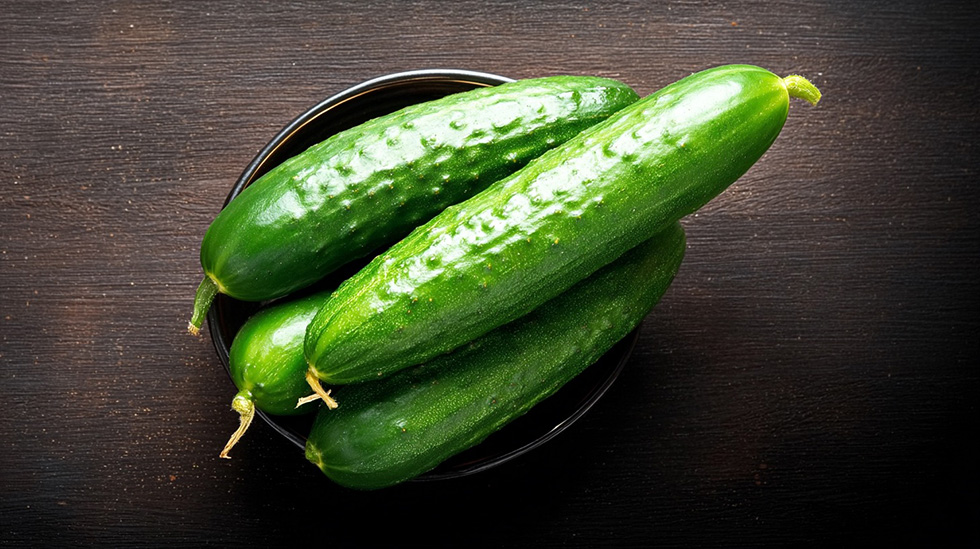Pickling cucumber – the crunchy summer favourite
Fresh, crunchy, refreshing – these are the words that come to mind when we think of a pickling cucumber. This popular vegetable is not just the star of summer salads, it’s much more than that: it’s a culinary treasure that has earned its place in our kitchens. But what is there to know about it and how can we make the most of it? Follow me and all will be revealed! 🥒

Pickling cucumbers (Latin name Cucumis sativus) belong to the pumpkin family and originated in Asia, where they have been cultivated for over 3000 years. It spread to Europe in Roman times and has not lost its popularity since.
It is important to clarify: cucumbers are not a single vegetable, but a whole family, within which there are several types:
- Pickling cucumber: a shorter, thicker, slightly knobbly-skinned variety, which is mainly suitable for fresh consumption, but is also excellent for pickling and pickling.
- English cucumbers: long, smooth-skinned, usually used in salads, with a milder flavour and higher water content.
- Fermenting cucumber: very similar to pickling cucumbers, but typically marketed in medium size and when younger – an essential ingredient for home pickled cucumbers.
This diversity makes cucumbers extremely useful in the kitchen. Pickling cucumbers are one of the most robust and versatile of these.
How important is it in the kitchen? Rating: 4/5
Not every recipe calls for pickling cucumbers, but when it comes to summer, they are a must! It’s perfect as a pickle, fresh in salads, with cold dishes or even grated into yoghurt dips. It’s a summer staple all over Europe, and in some cuisines (like Greek and Turkish) it’s even used in cooked dishes. It doesn’t get an A because it’s used less often in hot cooking (e.g. baking and cooking).
Which part is edible?
It’s the cucumber crop that we eat – and the good news is that it’s edible in its entirety! The skin is crisp and nutrient-rich, so it’s not worth peeling, especially if it’s fresh and chemical-free. The flower, stem and leaves are not edible, although in some cultures the flower is used as a decoration.
Health in cucumbers – what’s in this green delicacy?
Cucumbers are not only delicious, but also extremely healthy. Although it is low in calories, it contains a lot of useful substances:
- High water content – helps to hydrate the body
- Contains vitamin C, potassium, magnesium
- Good for digestion, especially if you eat the peel
- Cooling, anti-inflammatory
According to traditional medicine, it relieves bloating, helps the kidneys to work properly and is also recommended for skin problems – it is not by chance that it is used in cosmetics.
Production and season: when, where and how much?
Pickling cucumbers are typically a summer vegetable, growing from May to September in Hungary, but they are available in April if grown in the open air. It can be grown in glasshouses all year round and is available in winter, although it is more often imported at this time of year, mainly from Spain, the Netherlands or Greece.
In Hungary, the Southern Great Plain is the stronghold of cucumber production, but you can find small quantities of native cucumbers throughout the country.
How to choose a good pickling cucumber?
- Colour: should be bright green, not yellowish!
- Texture: firm to the touch, hard – if it’s soft or saggy, don’t buy it!
- Peel: slightly rugged but not too prickly – a sign of freshness
- Smell: if you rub the end, it should smell like fresh cucumber
Watch out for specimens that are too big – they are older, have thicker skins and contain more seeds.
Storage tips
Best fresh, but if you want to store them, refrigerate (between 5-10°C). Don’t store in a bag for long periods of time as they will shrivel – instead, wrap loosely in paper towels and place in a perforated bag or tray. This will keep them crisp for up to a week.
In the kitchens of the world
- Greece: the essential ingredient for the famous tzatziki
- Turkey: used in yoghurt salads, spicy
- India: as a refreshment with curries, even with chilli-mustard dressing
- Japan: pickled cucumber slices with rice
- Scandinavian countries: pickling in a sugar and vinegar broth for meat dishes
Classic recipe: homemade pickled cucumber
Ingredients:
- 1 kg of pickling or fermenting cucumbers
- 2-3 cloves of garlic
- fresh dill
- bread slice (sourdough or peasant bread)
- salt and water
Preparation: cut the cucumbers lengthwise and put them in a jar with garlic and dill. Make a stock (about 1 tbsp salt per 1 litre of water) and pour over the cucumbers. Put bread on top and leave to mature in a sunny place for 2-3 days. When ready, rinse with cold water and store in the fridge. Taste of summer in a jar! ☀️
How to use it in the kitchen?
- For salads: grated, sliced or diced – with dressing of vinegar, yoghurt, lemon
- For dipping: tzatziki, spicy sauce with yoghurt
- For sandwiches: fresh slices with a little butter or cream cheese
- For cold dishes: with ham, cheese, eggs as a refreshing addition
Spices that go well with it: dill, garlic, mint, parsley, lemon juice, cumin
Avoid pairing: very strong or sweet flavours – for example, cinnamon or cloves are not really suitable
Summary
Pickling cucumbers are a true summer friend: simple yet versatile, healthy, refreshing and very easy to incorporate into your daily diet. Whether it’s a classic pickle, a Mediterranean salad or a quick snack, you can always count on it. Don’t leave it out of your basket! 🛒
